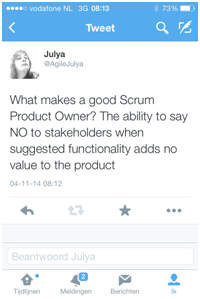SAY NO
November 27, 2014
 Recently I tweeted the following: “What makes a good Scrum Product Owner? The ability to say NO to stakeholders when suggested functionality adds no value to the product.” This was of course a tweet that didn’t just come out of nowhere. I have known a lot of Product Owners and some are really good. Responsibility for the product, the ROI from the product, the Product Backlog that is Ready, or Ready-Ready, or just a list of wishes… The reality is that the work of a Product Owner is hard. It’s a fulltime job! In organisations where I have coached or been a Scrum Master I have found a lot of examples of Product Owners that have been “given” this position, or who have made themselves the position and often they do the job as a side. But Product Ownership is HARD. And if you are the Product Owner of a new and exciting high profile product you will find that everyone will want to have an influence on the product. In large organisations where a new product will most likely give another boost in profits and will increase someones chances for promotion, higher KPI or other advantages, these someones will want to be able to influence this.more–>
Recently I tweeted the following: “What makes a good Scrum Product Owner? The ability to say NO to stakeholders when suggested functionality adds no value to the product.” This was of course a tweet that didn’t just come out of nowhere. I have known a lot of Product Owners and some are really good. Responsibility for the product, the ROI from the product, the Product Backlog that is Ready, or Ready-Ready, or just a list of wishes… The reality is that the work of a Product Owner is hard. It’s a fulltime job! In organisations where I have coached or been a Scrum Master I have found a lot of examples of Product Owners that have been “given” this position, or who have made themselves the position and often they do the job as a side. But Product Ownership is HARD. And if you are the Product Owner of a new and exciting high profile product you will find that everyone will want to have an influence on the product. In large organisations where a new product will most likely give another boost in profits and will increase someones chances for promotion, higher KPI or other advantages, these someones will want to be able to influence this.more–>
Scrum is all about trust, and we often think it’s the trust a Product Owner needs to have in the Development team, but this trust is much more. It’s also trust the organisation has in the Product Owner. One of the most important jobs for a Product Owner therefore is Stakeholder management. With the product that will boost the company’s ROI one of the stakeholders is obviously the upper management and controllers. The funding depends on them. And there is Marketing, Sales, Security, Maintenance, etc. So many stakeholder and in principle everyone can add to the Product Backlog. Often the items on the product backlog make sense. New product and new ideas, unique selling points, necessary functionality of a product. All these items are what a Product Owner needs to order. Which is more important, which will appease my stakeholders best, which will make users happy and return ROI. But the most important question a Product Owner will ask him or herself is “Which of these will add the most value, on the short and the long term”.
Sometimes a stakeholder will add an item that adds no value at all for whatever reason, maybe the functionality does not fit the product, maybe it is something that stems from misunderstanding the product and it does not fit the Product Vision. However… this non-value item might be invaluable to the Product Owner’s main stakeholder. This can lead to a dilemma. It might be because the Product Owner is prone to Political pressure, or there is an other reason why the Product Owner may consider the item. This is where the Product Owner needs to be strong. You may end up with functionality in the product that does not add value at all, or affects functionality that IS valuable. This may not seem serious, but it is also functionality that may define the product. It still has to be maintained, or it may be hard to consolidate.
Please Product Owners, learn to say NO, make it a diplomatic “no”, I know that you catch more flies with honey than with vinegar. But learn to say “no” anyway. It’s your Product Vision, YOU are the Product Owner. Your strength of will will be what defines the product.

 English | EN
English | EN 